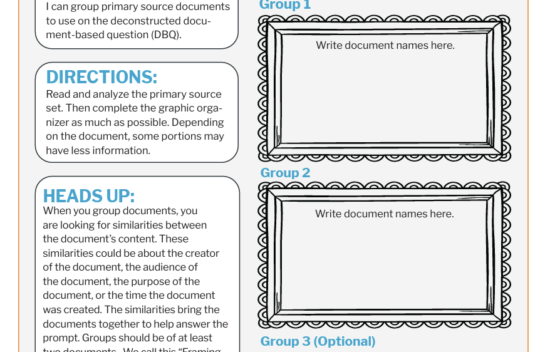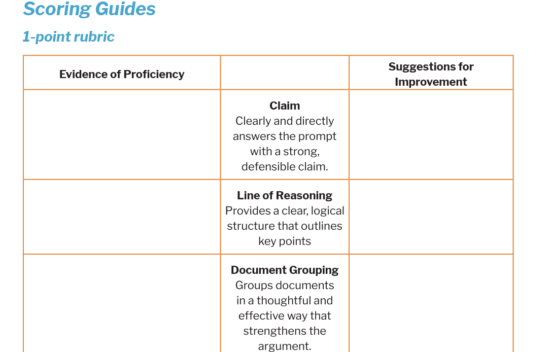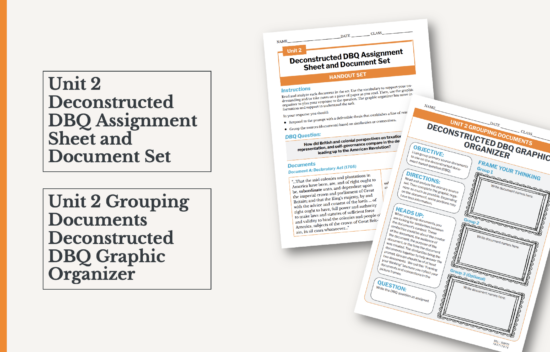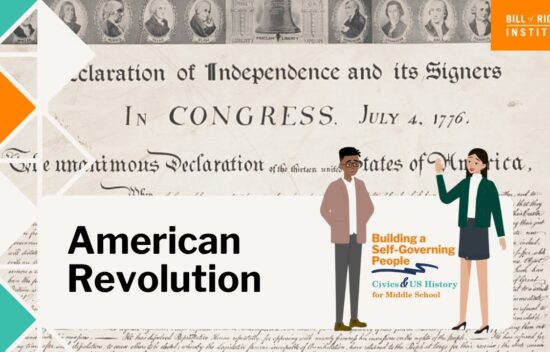
Unit 2: Grouping Sources and Thesis Deconstructed DBQ – Mini-Lesson
Lesson Components
Guiding Question:
How did British and colonial perspectives on taxation, representation, and self-governance compare in the decades leading up to the American Revolution?
Objections:
- Students will define and understand the purpose of grouping sources in historical writing.
- Students will analyze primary sources to develop a thesis in response to a historical prompt.
- Students will use a graphic organizer to outline their line of reasoning.
Student Resources
Document Set (choose 1)
- Unit 2: Deconstructed DBQ Assignment Sheet and Document Set
- Unit 2: Scaffolded Deconstructed DBQ Assignment Sheet and Document Set
Graphic Organizer
Teacher Resources
Facilitation Notes
- This is a mini-lesson. It is intended to be short and directly related to a specific skill. It will take 30-45 minutes of class time. It accompanies the mini-lesson slide deck.
- The mini-lesson is intended to help students develop the skill of grouping sources, which supports forming a strong thesis in historical writing. Students should be familiar with the concept of a thesis statement from the Unit 1 deconstructed DBQ, but they may need support in structuring their reasoning.
Anticipate (Optional)
Deconstructed DBQ Skill Video
- Assign, or watch as a whole group, the Deconstructed DBQ video for the unit.
- The video will introduce a new primary source from the time period, give historical context and analysis, and then lead students through using the source to answer the Deconstructed DBQ question with a thesis statement.
- Pause the video at the processing questions embedded in the video to prompt reflection and discussion.
Teacher Note: The Deconstructed DBQ videos work as a pre-teaching tool, but can also be used as a scaffolding support later in the mini-lesson. The video is based on a source not included in the Deconstructed DBQ document set, so that this video can be used as a resource in classrooms using the DBQ for skills building, assessment, or both.
Engage
- Begin by defining “grouping sources”: Identifying similarities or connections between sources to create logical categories for historical analysis.
- Draw students’ attention to the “Heads Up” section of their organizer. This will act as a support when they work on their own.
- Explain the purpose of grouping sources in organizing a DBQ argument and forming a thesis.
- Review an example thesis by using the example from the slides:
- Summer is the best season because the weather provides more opportunities for outdoor activities, people are more likely to travel to new places, and school is out.
- Ask students to identify the claim and the supporting reasons.
Explore
Primary Source Color-coding
- Distribute the Document Set (Documents A-D):
- Document A: Declaratory Act (1766)
- Document B: The Patriot – Samuel Johnson (1774)
- Document C: Common Sense – Thomas Paine (1776)
- Document D: Declaration of Independence (1776)
- Students will begin this activity by working independently. Give students 10–15 minutes to read all four documents carefully. As they read, they should use different colored highlighters to identify meaningful connections or shared ideas across the texts.
- Encourage students to focus on themes or concepts, rather than surface-level similarities like repeated words or phrases.
- For Example: A student might use blue to highlight quotes that argue the colonies should remain under British rule. They might use yellow to highlight quotes that criticize Britain’s taxation of the colonies.
- Students will track their color choices and the related themes on their graphic organizer handout. The handout provides space for up to six color-coded categories, but students do not need to use all six.
Primary Source Analysis
- Students will work in pairs or small groups to analyze one document and determine whether it represents the British or colonial perspective.
- Groups quickly present their findings in a round-robin and discuss how each document illustrates taxation, representation, and self-governance.
- As a class, use the graphic organizer to categorize evidence from the documents into:
- British Perspective: The Patriot and Declaratory Act
- Colonial Perspective: Common Sense and Declaration of Independence
- At this point, students complete the first page of the organizer.
Developing a Thesis Review
- Use the slides provided to review the definition and basics of writing a thesis.
- Guide students in crafting a sample thesis statement using the identified evidence.
- Example: British and colonial perspectives on taxation, representation, and self-governance differed in the decades leading up to the American Revolution. Documents like Common Sense and the Declaration of Independence show that the colonists felt unfairly taxed and denied selfgovernment, whereas the British perspective, as seen in The Patriot and the Declaratory Act, was that the colonies were still part of the empire and subject to British rule.
- Have students individually draft their own thesis statements using the Deconstructed DBQ: Grouping Sources Handout. Scaffolding note: The slide deck includes an additional example for advanced students with more complex reasoning.
Closing
- Peer review: Students will exchange thesis statements and provide feedback using the following questions:
- What are the similarities or connections used to create groups or categorizes?
- Do the groups match the sources?
- Does the thesis answer the prompt?
- Is the claim clear and defendable?
- Does it establish a logical line of reasoning?
- Wrap up with a discussion on key takeaways and the importance of grouping sources in historical writing.
Assess & Reflect
- Completed Thesis Statement and Grouping
- The completed handout with thesis statement and document grouping acts as the summative assessment for this mini-lesson.
AND/OR
- Reflection:
- Exit slip – What is one thing you learned today about grouping sources for historical writing?
Extend (Optional)
- For advanced students: Reduce the supports in the mini-lesson, allowing students to take more responsibility for writing and reasoning on their own. You can also have advanced students refine their thesis to address counterarguments or incorporate additional evidence.
- For struggling students: Provide sentence starters for thesis writing or allow them to verbally explain their reasoning before writing.





